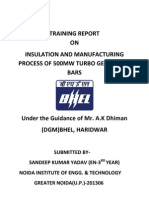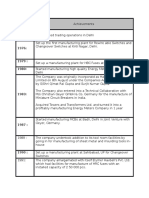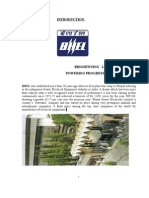0 ratings0% found this document useful (0 votes)
47 viewsMotors and Generators
Motors and Generators
Uploaded by
nsivasankar14ABB offers a comprehensive range of reliable and high efficiency motors and generators for all applications. It was formed in 1987 through the merger of Allmänna Svenska Elektriska Aktiebolaget (ASEA) and Brown, Boveri & Cie (BBC) to create a global industrial group. Through acquisitions and divestitures, ABB has shifted its business focus from heavy industries like power generation to areas like industrial automation, robotics, and renewable energy.
Copyright:
© All Rights Reserved
Available Formats
Download as DOCX, PDF, TXT or read online from Scribd
Motors and Generators
Motors and Generators
Uploaded by
nsivasankar140 ratings0% found this document useful (0 votes)
47 views3 pagesABB offers a comprehensive range of reliable and high efficiency motors and generators for all applications. It was formed in 1987 through the merger of Allmänna Svenska Elektriska Aktiebolaget (ASEA) and Brown, Boveri & Cie (BBC) to create a global industrial group. Through acquisitions and divestitures, ABB has shifted its business focus from heavy industries like power generation to areas like industrial automation, robotics, and renewable energy.
Original Description:
an
Original Title
An
Copyright
© © All Rights Reserved
Available Formats
DOCX, PDF, TXT or read online from Scribd
Share this document
Did you find this document useful?
Is this content inappropriate?
ABB offers a comprehensive range of reliable and high efficiency motors and generators for all applications. It was formed in 1987 through the merger of Allmänna Svenska Elektriska Aktiebolaget (ASEA) and Brown, Boveri & Cie (BBC) to create a global industrial group. Through acquisitions and divestitures, ABB has shifted its business focus from heavy industries like power generation to areas like industrial automation, robotics, and renewable energy.
Copyright:
© All Rights Reserved
Available Formats
Download as DOCX, PDF, TXT or read online from Scribd
Download as docx, pdf, or txt
0 ratings0% found this document useful (0 votes)
47 views3 pagesMotors and Generators
Motors and Generators
Uploaded by
nsivasankar14ABB offers a comprehensive range of reliable and high efficiency motors and generators for all applications. It was formed in 1987 through the merger of Allmänna Svenska Elektriska Aktiebolaget (ASEA) and Brown, Boveri & Cie (BBC) to create a global industrial group. Through acquisitions and divestitures, ABB has shifted its business focus from heavy industries like power generation to areas like industrial automation, robotics, and renewable energy.
Copyright:
© All Rights Reserved
Available Formats
Download as DOCX, PDF, TXT or read online from Scribd
Download as docx, pdf, or txt
You are on page 1of 3
Motors and Generators
ABB offers a comprehensive range of reliable and high efficiency motors
and generators for all applications.
ABB has what it takes to help every industry and application reach new levels of efficiency
and energy savings even under the most demanding conditions. Combining the best
available materials with superior technology, the electric motors and generators are
designed to operate reliably no matter how challenging the process or application, and to
have low life cycle costs.
Predecessor companies
See also: Allmänna Svenska Elektriska Aktiebolaget and Brown, Boveri & Cie
Allmänna Svenska Elektriska Aktiebolaget (General Swedish Electrical Limited Company, ASEA) was founded in
1883 by Ludvig Fredholm[6] in Västerås as manufacturer of electrical light and generators. Brown, Boveri & Cie (BBC)
was formed in 1891 in Baden, Switzerland, by Charles Eugene Lancelot Brown and Walter Boveri[7] as a Swiss group
of electrical engineering companies producing AC and DC motors, generators, steam turbines and transformers.
ABB around the world.[vague]
Formation and early years
On 10 August 1987, ASEA A.B. and BBC A.G. announced they would merge to form ABB Asea Brown Boveri Ltd.
The new corporation was to be based in Zurich, Switzerland, with each parent company holding 50 percent. At the
time, both companies were considered leaders in a field then known as the "electrotechnical industry." The merger
between these two medium-sized companies created a global industrial group with revenue of $18 billion and
160,000 employees. The rationale behind the "merger of equals" was to create a company that could compete
internationally by offering products, services and solutions capable of driving scalable, sustainable, industrial and
economic development for an increasingly global economy.
When ABB began operations on January, 5, 1988, its core operations included power generation, transmission and
distribution; electric transportation; and industrial automation and robotics.
In its first year, ABB made some 15 acquisitions, including the environmental control group Fläkt AB of Sweden, the
contracting group Sadelmi/Cogepi of Italy, and the railway manufacturer Scandia-Randers A/S of Denmark.
In 1989, ABB purchased an additional 40 companies, including Westinghouse Electric's transmission and distribution
assets, and announced an agreement to purchase the Stamford, Connecticut-based Combustion Engineering (C-E).
These two major acquisitions broadened ABB's worldwide power transmission and distribution operations and
provided it with substantial market share in the business of designing and building power generation facilities in the
United States.
The following year, ABB brought the robotics business of Cincinnati Milacron in the US. The acquisition expanded
ABB's presence in automated spot-welding and positioned the company to better serve the American automotive
industry. ABB's 1991 introduction of the IRB 6000 robot demonstrated its increased capacity in this field. The first
modular robot, the IRB 6000 can be reconfigured to perform a variety of specific tasks. At the time of its launch, the
IRB 6000 was the fastest and most accurate spot-welding robot on the market.
In the early 1990s, ABB started expanding in Central and Eastern Europe. By the end of 1991, the company
employed 10,000 people in the region. The following year, that number doubled. A similar pattern played out in Asia,
where economic reforms in China and the lifting of some Western sanctions helped open the region to a new wave of
outside investment and industrial growth. By 1994, ABB had 30,000 employees and 100 plants, engineering, service
and marketing centers across Asia - numbers that would continue to grow. Through the 1990s, ABB continued its
strategy of targeted expansion in Eastern Europe, the Asia-Pacific region and the Americas.
In 1995, ABB agreed to merge its rail engineering unit with that of Daimler-Benz AG of Germany. The goal was the
create the world's largest maker of locomotives and railway cars. The new company, ABB Daimler-Benz
Transportation (Adtranz), had an initial global market share of nearly 12 percent.
A few months after the July 1997 Asian financial crisis, ABB announced plans to accelerate its expansion in Asia. The
company also acted to improve the productivity and profitability of its Western operations, taking an $850 million
restructuring charge as it shifted more resources to emerging markets and scaled back some facilities in higher-cost
countries.
In 1998, ABB acquired Sweden-based Alfa Laval's automation unit, which at the time was one of Europe's top
suppliers of process control systems and automation equipment. [8]
As a final step in the integration of the companies formerly known as ASEA and BBC, in 1999 the directors
unanimously approved a plan to create a unified, single class of shares in the group.
That same year, ABB completed its purchase of Elsag Bailey Process Automation NV, a Netherlands-based maker of
industrial control systems, for $2.1 billion [9]. The acquisition increased ABB's presence in the high-tech industrial
robotics and factory control system sectors, which reducing its reliance on traditional heavy engineering sectors such
as power generation and transmission.
Shift in business focus
In 1999, the company sold its stake in the Adtranz train-building business to DaimlerChrysler. Instead of building
complete locomotives, ABB's transportation activities shifted increasingly toward traction motors and electric
components. [10]
That same year, ABB and France-based Alstom announced the merger of their power generation businesses in a 50-
50 joint company, ABB Alstom Power. Separately, ABB agreed to sell its nuclear power business to BNFL of
Britain.[11]
In 2000, ABB divested its interests in ABB Alstom Power and sold its boiler and fossil-fuel operations to
Alstom.[12] Thereafter, ABB’s power business was focused on renewable energy and transmission and distribution.
In 2002, ABB announced its first-ever annual loss, a $691 million net loss for 2001. [13]The loss was caused by ABB's
decision to nearly double its provisions for settlement costs in asbestos-related litigation against Combustion
Engineering in the US from $470 million to $940 million. The claims were linked to asbestos products sold by
Combustion Engineering prior to its acquisition by ABB.
At the same time, ABB's board announced it would seek the return of money "paid in excess of obligations to Goran
Lindahl and to Percy Barnevik," two former chief executive officers of the group. Barnevik received some $89 million
in pension benefits when he left ABB in 2001; Lindahl, who succeeded Barnevik as CEO, had received $50 million in
pension benefits.[14]
In 2006, ABB put an end to its financial uncertainties by finalizing a $1.43 billion plan to settle asbestos liabilities
against its US subsidiaries, Combustion Engineering and ABB Lummus Global, Inc. [15] In August 2007, ABB Lummus
Global, ABB's downstream oil and gas business, was sold to CB&I. [16] In 2004, ABB had sold its upstream oil and gas
business, ABB Vetco Gray. ABB's plan going forward was to support the oil and gas industry with its core automation
and power technology businesses.
In 2008, ABB agreed to acquire Kuhlman Electric Corporation, a US-based maker of transformers for the industrial
and electric utility sectors. In December 2008, ABB acquired Ber-Mac Electrical and Instrumentation to expand its
presence in Western Canada's oil and gas industries.
On 10 January 2011, ABB invested $10 million in ECOtality, a San Francisco-based developed of charging stations
and power storage technologies, to enter North America's electric vehicle charging market. [17] On July 1, ABB
announced the acquisition of Epyon B.V. of the Netherlands, an early leader in the European EV-charging
infrastructure and maintenance markets.[18]
In 2011, ABB acquired Baldor Electric for $4.2 billion in an all-crash transaction. The move aligned with ABB's
strategy to increase its market share in the North American industrial motors business. [19]
On 30 January 2012, ABB acquired Thomas & Betts, a North American leader in low voltage products for industrial,
construction and utility applications, in a $3.9 billion cash transaction. [20] On June 15, 2012, it completed the
acquisition of commercial and industrial wireless technology specialists Tropos.
In July 2013, ABB acquired Power-One in a $1 billion all-cash transaction, to become the leading global manufacturer
of solar inverters.[21] Also in 2013, Fastned selected ABB to supply more than 200 Terra fast-charging stations along
highways in the Netherlands. Ulrich Spiesshofer was named ABB's CEO, succeeding Joe Hogan. [22]
On 6 July 2017, ABB announced it had completed its acquisition of Bernecker + Rainer Industrie-Elektronik (B&R),
the largest independent provider of product and software-based, open-architecture solutions for machine and factory
automation.[23]
In 2018, to promote its standing as the provider with largest installed base of EV fast-charging stations worldwide,
ABB became the title partner of the ABB FIA Formula E Championship, the world's first fully electric international FIA
motorsport series. [24]
On 30 June 2018, ABB completed its acquisition of GE Industrial Solutions, General Electric's global electrification
business. [25]
On 17 December 2018, ABB announced it had agreed to sell 80.1% of its Power Grids business to Hitachi Ltd. The
transaction, which places a value of $11 billion on the business, is expected to close in the first half of 2020. [26]
You might also like
- List of Electrical Companies.Document5 pagesList of Electrical Companies.Sebin SabuNo ratings yet
- History of Schneider ElectricDocument12 pagesHistory of Schneider ElectricKerin Berliana100% (1)
- Lecture Notes:: Risk Assessment & Risk ManagementDocument25 pagesLecture Notes:: Risk Assessment & Risk Managementeladio30No ratings yet
- Revenue of Top 5000 Companies FromDocument654 pagesRevenue of Top 5000 Companies FromReckon IndepthNo ratings yet
- Hill and Jones Chapter 12 SlidesDocument31 pagesHill and Jones Chapter 12 SlidesC Sandeep ReddyNo ratings yet
- Simple Social Security TrustDocument2 pagesSimple Social Security TrustFreeman Lawyer100% (8)
- ABB India Limited, Industrial TrainingDocument18 pagesABB India Limited, Industrial TrainingPiyush chaudhari100% (1)
- ABB - WikipediaDocument16 pagesABB - WikipediaSumith VkNo ratings yet
- Revival of ABBDocument5 pagesRevival of ABBmukulNo ratings yet
- Abb HistoryDocument7 pagesAbb HistoryKushagra MathurNo ratings yet
- ABB Industrial Sensor Ss PRESENTATIONSDocument12 pagesABB Industrial Sensor Ss PRESENTATIONSAli KhanNo ratings yet
- Prabu Kalidoss 2015H149240PDocument2 pagesPrabu Kalidoss 2015H149240PPrabu KalidossNo ratings yet
- ABB I RWEDocument1 pageABB I RWEPredrag VucinicNo ratings yet
- BHELDocument20 pagesBHELRaghavendra SattigeriNo ratings yet
- ABM, TATA, Boeing, GENERACDocument4 pagesABM, TATA, Boeing, GENERACkudukachiNo ratings yet
- ABB LTDDocument21 pagesABB LTDUdaibhanSinghNo ratings yet
- Exide GDFG FD GF FGG FDocument21 pagesExide GDFG FD GF FGG FKiran KumarNo ratings yet
- Chapter Page NoDocument17 pagesChapter Page NoSameer Kumar SinghNo ratings yet
- Contact 1/14: ServiceDocument24 pagesContact 1/14: ServiceCONTACTABBNo ratings yet
- Synopsis BhelDocument7 pagesSynopsis BhelDeepak SattiNo ratings yet
- ABB India IntroductionDocument4 pagesABB India Introductionblackdiamond89No ratings yet
- FROM-4.06.2009 TO 19.07.2009: Under The Guidance ofDocument11 pagesFROM-4.06.2009 TO 19.07.2009: Under The Guidance ofSooraj Singh JalalNo ratings yet
- Global Top 20 Hydrogen Electrolyzer Manufacturers (2023)Document11 pagesGlobal Top 20 Hydrogen Electrolyzer Manufacturers (2023)Sumukh MahekarNo ratings yet
- ABB India IntroductionDocument7 pagesABB India IntroductionAjeet Kumar SinghNo ratings yet
- Wavepro LT 201201d02 enDocument40 pagesWavepro LT 201201d02 endiscovery198No ratings yet
- Case Study - Elsewedy Electric - 2 PDFDocument4 pagesCase Study - Elsewedy Electric - 2 PDFThủy NguyễnNo ratings yet
- Case Study - Elsewedy Electric - 2Document4 pagesCase Study - Elsewedy Electric - 2Thủy NguyễnNo ratings yet
- Study of Turbo Generator Samir PoulDocument76 pagesStudy of Turbo Generator Samir Pouldhathu11100% (1)
- EuValue - ABB India Ltd.Document6 pagesEuValue - ABB India Ltd.Chanchal BiswasNo ratings yet
- Abb Group Presentation - January 2011Document21 pagesAbb Group Presentation - January 2011César PalleteNo ratings yet
- Esab Naren's WorkDocument9 pagesEsab Naren's WorkSubha BharathyNo ratings yet
- Atlas CopcoDocument12 pagesAtlas CopcoMAQUINARIAPESADA100% (1)
- ABB Group Presentation - Sept 2013Document21 pagesABB Group Presentation - Sept 2013Nishant GoyalNo ratings yet
- 1.1 Profile of The Company (Bhel) : Chapter - IDocument59 pages1.1 Profile of The Company (Bhel) : Chapter - IVenkatasubramanian SubramanianNo ratings yet
- Bhel Report 500MW SandyDocument29 pagesBhel Report 500MW SandyAtul TripathiNo ratings yet
- Press Rel230310Document3 pagesPress Rel230310keppelverolmeNo ratings yet
- ABB Wins $150 Million Order To Grid-Connect World's Largest Offshore Wind FarmDocument2 pagesABB Wins $150 Million Order To Grid-Connect World's Largest Offshore Wind FarmPedro PereiraNo ratings yet
- L&TDocument39 pagesL&TNidhi AshokNo ratings yet
- Project Inventory ManagementDocument47 pagesProject Inventory ManagementNikhil BudhirajaNo ratings yet
- SIEMENSDocument16 pagesSIEMENSHarika Shekapuram12No ratings yet
- sản phẩm đóng cắt cao thế Hitachi- ABBDocument3 pagessản phẩm đóng cắt cao thế Hitachi- ABBPhong Nguyen HungNo ratings yet
- Havells MilestonesDocument9 pagesHavells MilestonesRajeevNo ratings yet
- Mittal Steel Company FinalDocument38 pagesMittal Steel Company FinalSandeep GudimaniNo ratings yet
- ABB OverviewDocument45 pagesABB Overviewjosleiny100% (1)
- ManagementDocument8 pagesManagementskgrover5524No ratings yet
- Training Report Done at BHEL For Electrical EngineeringDocument44 pagesTraining Report Done at BHEL For Electrical Engineeringgandhikapil13182% (11)
- Shrenik Abb CompanyDocument10 pagesShrenik Abb CompanysmartakshNo ratings yet
- Turbinereport Sumitted in Tula S in 7th Sem.Document47 pagesTurbinereport Sumitted in Tula S in 7th Sem.Nilabjo Kanti PaulNo ratings yet
- Commercialization RPT FinalDocument10 pagesCommercialization RPT FinalRadu Victor TapuNo ratings yet
- De BrochureDocument9 pagesDe BrochureKeyur PandyaNo ratings yet
- Training Report: Six Months Industrial Training ATDocument78 pagesTraining Report: Six Months Industrial Training ATvaruns1ngh0% (1)
- ABB and Samsung SDI Join Forces To Develop Microgrids GloballyDocument1 pageABB and Samsung SDI Join Forces To Develop Microgrids GloballyNuno TomásNo ratings yet
- Anitha ProjectDocument108 pagesAnitha ProjectmadhurichayanamNo ratings yet
- Kvssnrao'S Handbook of Mergers and AcquisitionsDocument18 pagesKvssnrao'S Handbook of Mergers and AcquisitionsSumeet MukulNo ratings yet
- 09 51 LondonDocument1 page09 51 Londonmashdi2003No ratings yet
- Bhel Haridwar Summer Training Report Electronic & CommunicationDocument22 pagesBhel Haridwar Summer Training Report Electronic & Communicationritika_arora19067% (3)
- SteagDocument7 pagesSteaglea grace raupanNo ratings yet
- Aman Bhel Report1Document35 pagesAman Bhel Report1vivekNo ratings yet
- EU China Energy Magazine 2023 April Issue: 2023, #3From EverandEU China Energy Magazine 2023 April Issue: 2023, #3No ratings yet
- EU China Energy Magazine 2022 Christmas Double Issue: 2022, #11From EverandEU China Energy Magazine 2022 Christmas Double Issue: 2022, #11No ratings yet
- EU China Energy Magazine 2022 Summer Double Issue: 2022, #6From EverandEU China Energy Magazine 2022 Summer Double Issue: 2022, #6No ratings yet
- H2SDocument2 pagesH2Snsivasankar14No ratings yet
- Tetraethyl LeadDocument1 pageTetraethyl Leadnsivasankar14No ratings yet
- GM 5/15kV MV SwitchgearDocument1 pageGM 5/15kV MV Switchgearnsivasankar14No ratings yet
- InclDocument1 pageInclnsivasankar14No ratings yet
- Architecture and Design: Shah Jahan Mumtaz Mahal Persian Gauhara Begum Mumtaz MahalDocument4 pagesArchitecture and Design: Shah Jahan Mumtaz Mahal Persian Gauhara Begum Mumtaz Mahalnsivasankar14No ratings yet
- Tɑ DƷ MƏ Hɑ L, Tɑ Ʒ-/ Hindi (Ta DƷ Mɛ Ɦ (Ə) L) Mausoleum Yamuna Agra Mughal Emperor Shah Jahan Tomb Mumtaz Mahal Mosque CrenellatedDocument1 pageTɑ DƷ MƏ Hɑ L, Tɑ Ʒ-/ Hindi (Ta DƷ Mɛ Ɦ (Ə) L) Mausoleum Yamuna Agra Mughal Emperor Shah Jahan Tomb Mumtaz Mahal Mosque Crenellatednsivasankar14No ratings yet
- Motorcycle Rider Postures: An MSF Rider Course For NovicesDocument3 pagesMotorcycle Rider Postures: An MSF Rider Course For Novicesnsivasankar14No ratings yet
- Today: Technical AspectsDocument3 pagesToday: Technical Aspectsnsivasankar14No ratings yet
- Motors and GeneratorsDocument1 pageMotors and Generatorsnsivasankar14No ratings yet
- Rider Education: ModelsDocument1 pageRider Education: Modelsnsivasankar14No ratings yet
- AnDocument1 pageAnnsivasankar14No ratings yet
- GM 5/15kV MV SwitchgearDocument1 pageGM 5/15kV MV Switchgearnsivasankar14No ratings yet
- ScribDocument2 pagesScribnsivasankar14No ratings yet
- GM 5/15kV MV SwitchgearDocument1 pageGM 5/15kV MV Switchgearnsivasankar14No ratings yet
- Grandvision 2019Document206 pagesGrandvision 2019gsdsfsdfsfsNo ratings yet
- Additional Cases: CASE 8.2Document4 pagesAdditional Cases: CASE 8.2le sageNo ratings yet
- Factors of ProductionDocument3 pagesFactors of ProductionArisha NicholsNo ratings yet
- SAP MRP DetailDocument45 pagesSAP MRP Detailvijay prabhu100% (1)
- MateriDocument5 pagesMateriHANA PRISKILANo ratings yet
- Proposed Rule: Income Taxes: Controlled Foreign Corporations and Other Property Exclusion From Gross Income of Previously Taxed Earnings and ProfitsDocument25 pagesProposed Rule: Income Taxes: Controlled Foreign Corporations and Other Property Exclusion From Gross Income of Previously Taxed Earnings and ProfitsJustia.comNo ratings yet
- Share Prices8Document1 pageShare Prices8AsifNoorNo ratings yet
- Haryana Bus RootsDocument114 pagesHaryana Bus RootsSudhir Maherwal100% (1)
- M&a in INDIA.... Post LiberilisationDocument93 pagesM&a in INDIA.... Post LiberilisationilotohevNo ratings yet
- Selling Skills and StrategiesDocument54 pagesSelling Skills and Strategieskokila.nn7900No ratings yet
- MAS-Results-Presentation-and-Company-Profile-30-June-2022 13Document1 pageMAS-Results-Presentation-and-Company-Profile-30-June-2022 13Vlad IonescuNo ratings yet
- The Role of Engineering Entrepreneurship in The Sustainable Development of The Nigerian EconomyDocument12 pagesThe Role of Engineering Entrepreneurship in The Sustainable Development of The Nigerian EconomyAnonymous tSYkkHToBP100% (1)
- 12 Economics Notes Macro Ch02 Money and BankingDocument6 pages12 Economics Notes Macro Ch02 Money and BankingRitika89% (9)
- Charter Cleaning Company Ch4Document2 pagesCharter Cleaning Company Ch4Kaitlyn PawlowskiNo ratings yet
- ABDULLA QAQC Painting& Coating InspectorDocument5 pagesABDULLA QAQC Painting& Coating InspectorawaisNo ratings yet
- Consumer Behavior Towards Birla Sunlife Insurance Ltd.Document66 pagesConsumer Behavior Towards Birla Sunlife Insurance Ltd.Sonu GoyalNo ratings yet
- Optimisation of Materials Handling Fleet Performance at Nchanga Open Pit MineDocument27 pagesOptimisation of Materials Handling Fleet Performance at Nchanga Open Pit Mineفردوس سليمانNo ratings yet
- Review #14-019 Bayfront Park VIP Complimentary Tickets - FINALDocument17 pagesReview #14-019 Bayfront Park VIP Complimentary Tickets - FINALal_crespoNo ratings yet
- Sample Counter Memorandum HLURB CaseDocument13 pagesSample Counter Memorandum HLURB Casepopoy cayoneNo ratings yet
- PMI & PME Laboratorium HematologiDocument76 pagesPMI & PME Laboratorium Hematologiibnunadhif haryantoNo ratings yet
- 9/19/17 Shakopee City Council MeetingDocument467 pages9/19/17 Shakopee City Council MeetingBrad TabkeNo ratings yet
- Cost of QualityDocument9 pagesCost of QualityMuhammadZubair0% (1)
- Same Day Ach Debit ReportingDocument1 pageSame Day Ach Debit ReportingMARSHA MAINESNo ratings yet
- Dalda Marketing PlanDocument15 pagesDalda Marketing PlanHamza Khaqan0% (1)
- Case Study Venezuela International FinanceDocument4 pagesCase Study Venezuela International FinanceSairaNo ratings yet
- BLACKBOOKDocument46 pagesBLACKBOOKPrem JainNo ratings yet







































































































